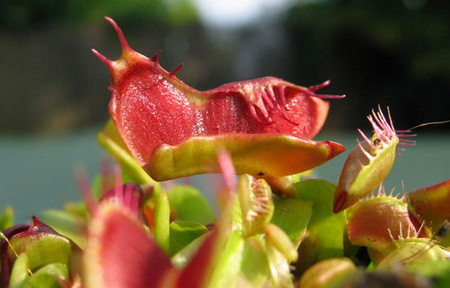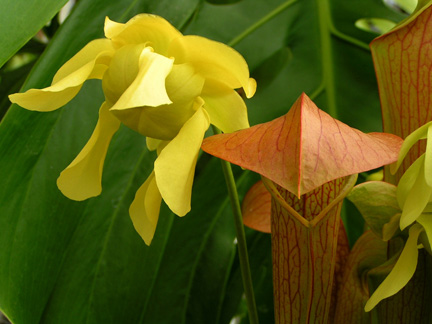|
Carnivorous Plant Newsletter
Volume 40, Number 3, September 2011, pages 95 - 98
New Cultivars
Dionaea ‘Fondue’
Sarracenia ‘Godzuki’
Utricularia ‘Merrie Heart’
Dionaea muscipula ‘Fondue’
Submitted: 22 March 2011
Dionaea muscipula ‘Fondue’ was found at the Carniflora open day on May 17, 2008. The most
spectacular feature of this new cultivar is the strange shape of the traps — they look like molten or
melted plastic (see Fig. 1). During spring, the traps can look like the typical Venus flytrap, but during
summer and autumn most of the later traps look molten (see Fig. 2), even petioles can appear molten
(see Fig. 3). Sometimes plants do not produce typical traps in the spring, but directly produce molten
traps. Because of the shape of the traps, this Venus flytrap does not catch much prey so the inside
of the traps are a deep red color during most of the year. Fondue means molten in French. Vegetative
propagation is necessary to maintain the unique features of this plant.
—Guillaume Bily • Guidel • France
 
Figure 1: Molten traps of Dionaea muscipula ‘Fondue’.

Figure 2: Normal and molten traps of Dionaea muscipula ‘Fondue’.

Figure 3: Molten petioles of Dionaea
muscipula ‘Fondue’.
Sarracenia ‘Godzuki’
Submitted: 13 June 2011
Many years ago I received this clone from Tom Kahl, who had received it from Leo Song. Leo
managed the greenhouses at California State University at Fullerton for many years and was also
co-editor of CPN for a long time.
Sarracenia ‘Godzuki’ is a clonal selection of a cross Leo did between S. oreophila and S. minor (S. oreophila × minor). My nursery California Carnivores has sold and distributed many of these
plants under the hybrid name Sarracenia oreophila × minor.
Sarracenia ‘Godzuki’ is a vigorous, fast-growing plant that readily spreads and clumps in cultivation,
producing many pitchers throughout the growing season. The pitchers average about 25 cm
in height, but can reach up to 45 cm. The domed, semi-curved lid completely covers the mouth and
its exterior is heavily veined and becomes copper red in full sun, while the interior becomes equally
flushed with a bronze-red coloration. As it ages, the entire tube of the pitcher can become rather
bronzy red against a green to olive background.
Several things are particularly noteworthy in S. ‘Godzuki’. The medium-sized bright yellow/green flowers open simultaneously with the opening of the first pitchers of the season (see Fig. 4
and Front Cover). The flower petals can last in prime condition for up to three weeks, around three
times longer than typical American pitcher plants.
It is most unusual, but we have never seen pollen released by the anthers, however the stigmas
are receptive to the pollen of other Sarracenia.
Clumps of this clone can produce a floriferous display in spring. All of the pitchers face inward,
toward the center growth point of the plant. The plant is very cold hardy, since S. oreophila is one
of its parents.
It is the lizard-like appearance of S. ‘Godzuki’ that inspired us to name this clone after the son of Godzilla, a famous character in many Toho Film Productions.
—Peter D’Amato • California Carnivores • 2833 Old Gravenstein Hwy • Sebastopol, CA 95472 • USA • califcarn@aol.com

Figure 4: Sarracenia ‘Godzuki’ pitcher and flower. Photo by Damon Collingsworth.

Front Cover: The cultivar Sarracenia ‘Godzuki’. Photo by Damon Collingsworth.
Utricularia ‘Merrie Heart’
Submitted: 13 June 2011
Utricularia livida is a popular plant in cultivation, however most clones of this species originated
from South Africa. Strangely enough, this species is also widespread throughout Mexico.
The Mexican variety is
even more attractive in flower
than the African variety
and is equally easy to grow.
It flowers prolifically, most
often from spring through
autumn, but it can bloom in
winter as well if kept warm
and in high light levels. It
is tolerant of light frost and
brief freezes.
The flower stalks average
7.5 to 15 cm in height but
can be taller, with upper portions
of the stalk each lasting
several weeks in bloom. The
flower’s apron-like lower lip
is slightly irregular along its
edge, suffused with purpleviolet
coloration, and measures
nearly 1 cm across (see
Fig. 5). The tiny upper lip is
two–pronged. The forward
facing curved spur is hidden
below the larger lower
lip and is also violet in color.
There is no yellow throat in the spur, as in its African sibling. It has never produced seed to my
knowledge, but is easily propagated through divisions. The sizeable surface stolon are irregularly
tear-drop shaped and measure roughly 1 cm in length.
We have named this plant Utricularia ‘Merrie Heart’ after the affectionate spelling Francis Ernest
Lloyd used for his beloved wife, Mary Hart. Mary was born November 6, 1865 in Boston, Massachusetts
and was a graduate of Wellesley College. She was a professor of Biology at the Western
College for Women, in Oxford, Ohio until she married Lloyd in 1903. She died in 1948 in Carmel,
California.
Lloyd’s obsession was Utricularia, and U. lloydii is named after him. The Lloyds lived in Mexico
for some years. See my article “Lloydie” in CPN, Vol. 39, No. 2, June 2010.
—Peter D’Amato • California Carnivores • 2833 Old Gravenstein Hwy • Sebastopol, CA 95472
• USA • califcarn@aol.com

Figure 5: Utricularia ‘Merrie Heart’ flowers.
|

